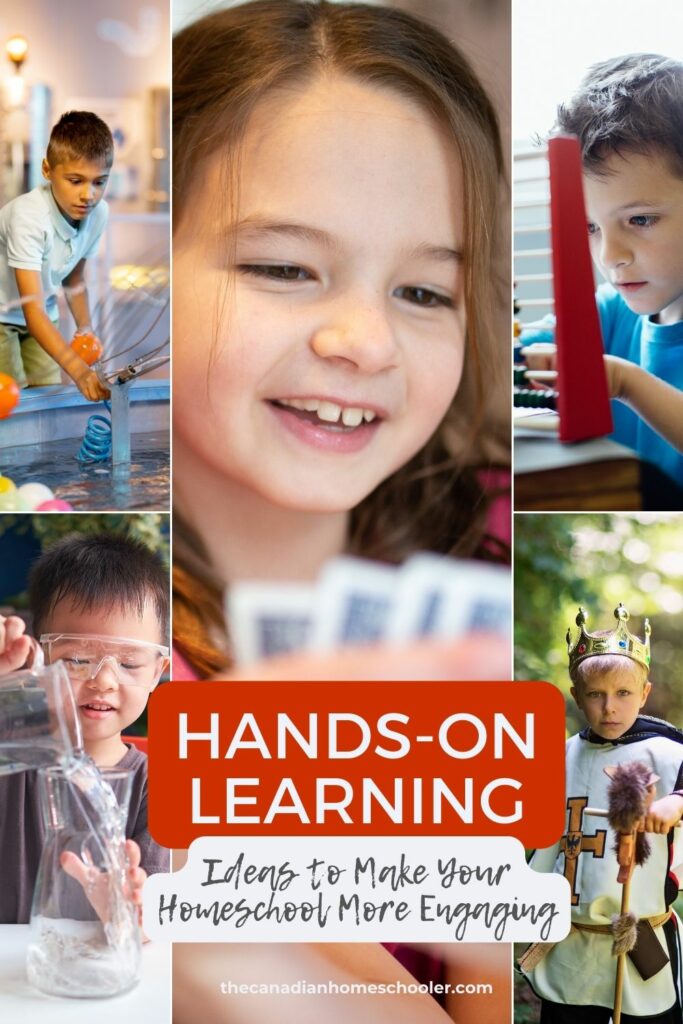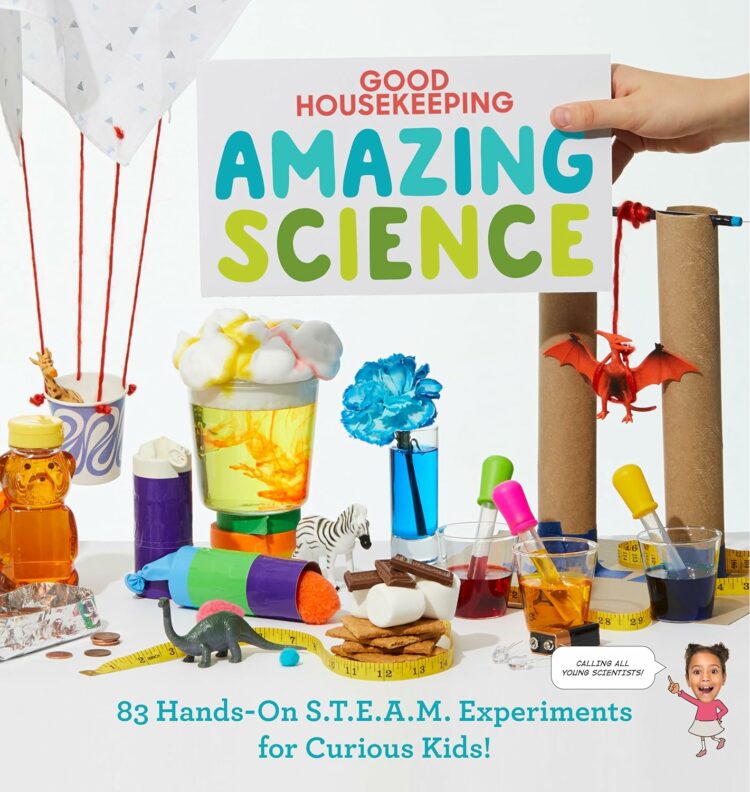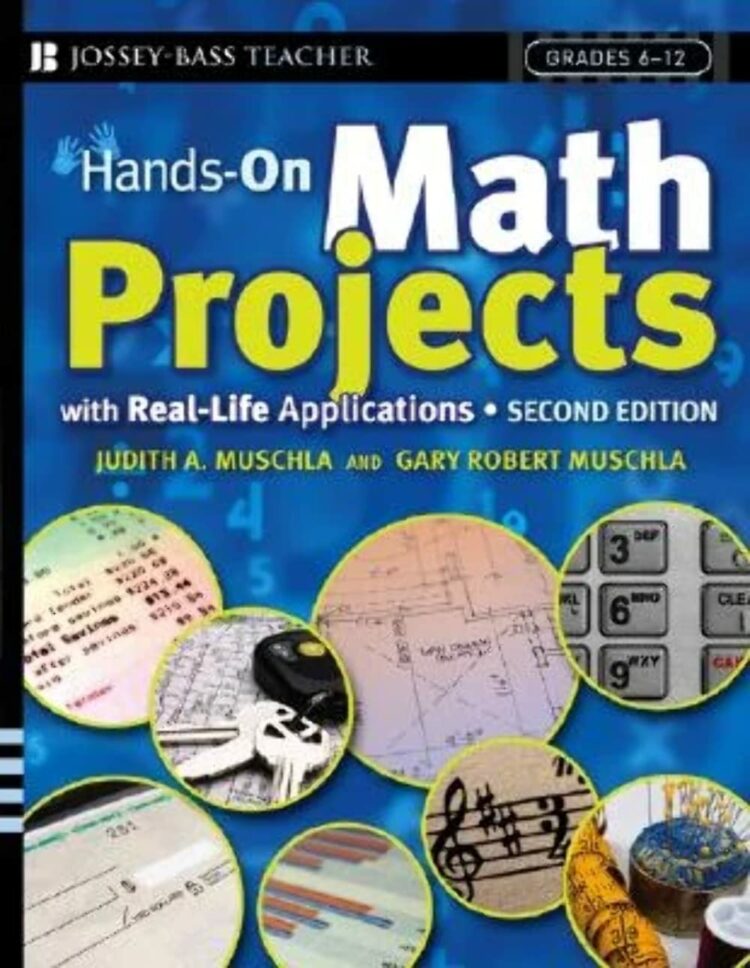Hands-on learning is one of my favourite ways to help kids learn. It takes what is being taught in a lesson and makes it real, in a tactile “I did it!” kind of way. Hands-on learning engages learners actively, allowing them to explore concepts through practical experiences rather than passive absorption of information.
In this blog post, we’ll explore the significance of hands-on learning and explore how it can enrich the educational experience in your homeschool.

This post contains affiliate links.
What is Hands-on Learning?
Hands-on Learning has two parts. Being hands-on and learning.
From the Collins Dictionary: “hands-on experience or work involves actually doing a particular thing, rather than just talking about it or getting someone else to do it” and “If you learn something, you obtain knowledge or a skill through studying or training.”
So, basically, hands-on learning is doing something to obtain knowledge or skill.
In 2015, a study was led by a team from the University of Chicago which used brain scanning to observe the difference between college students who had the opportunity to explore concepts with a hands-on learning activity and those who hadn’t. Now, this study seems focused on testing recall results, but it did show an interesting response in the brain – lighting up sensory and motor related areas when asked to recall a concept learned through the hands-on portion.
Prof. Sian Beilock, a world-leading cognitive scientist who directed the research during this study, said in the UChicago article about this learning method: “When we’re thinking about math or physics, getting students to actually physically experience some of the concepts they’re learning about changes how they process the information, which could lead to better performance on a test.”
At least part of the reason that this is true is because students aren’t just passively absorbing information presented to them. Think of how many times your kids tune out or turn off when they aren’t interested. Shifting the lesson to doing something gets them actively engaged and curious, which makes them interested in what they are learning.
Benefits of Hands-On Learning
Along with the ability to “test better” – which isn’t really something most homeschoolers are aiming for, hands-on learning offers a lot of other benefits as well.
Critical Thinking: Activities often require a lot of problem solving skills and decision making, especially when we, as teachers, give space to our kids as they work through the activities. It’s totally fine to allow them to fail (as long as it’s safe), to try again, and to change things. Experiments don’t always work. But understanding why and being willing to make adaptations to result in success can really be a key part of the hands-on learning experience.
Creativity: There are lots of opportunities to include creativity into a hands-on learning experience. For example, art projects, nature journaling, building with LEGO, making a model, using CAD programs for 3D designs, and more. Taking the opportunity to have your child use creative parts of their brains adds an extra element of learning to the experience too!
Communication: Doing things, especially when you do them with others, requires communication skills to work together. As a parent, it’s also a great opportunity to ask open-ended questions (any question that doesn’t require a yes or no answer).
Fun: Kids LOVE hands-on learning! They love the opportunity to have fun instead of just sitting and doing another worksheet.
Confidence: When kids DO things and they turn out – they feel incredibly successful and proud of themselves, especially if it was hard!
Sneak Schooling: Any opportunity I can sneak in learning is a win for me! So often, things can be explored with hands-on activities in a way that doesn’t even feel like “school.” Some examples of these are educational board games and baking.
Using Hands-On Activities in Your Homeschool
Hands-on learning is much more common in preschool and the early years of learning because people know that young children do best with they can explore the world around them. But it’s important to know that hands-on learning is key for all ages – from infancy through to adulthood. We need to find ways to encourage it even in our older learners and especially when topics get more difficult and information dense.
But how can we practically apply hands-on learning in our homeschool?
Science & Technology
The opportunity for demonstration, experiments, and lab work is naturally ingrained into science. There are so many ways to “see” scientific concepts. In fact, if you choose to use a science curriculum, they often include experiments right into the program.
Elementary years
A fun and simple way to add an element of science hands-on is with science kits. You can find a kit for many different topics – from electricity to geology to space to the laws of motion. You can find these online from the Learning House, CHER, Bookout.ca, and Amazon, but make sure to also check places like the local dollar store.
Another option is to buy a science subscription box. These show up at your door monthly (or whatever the subscription includes) and is full of themed activities that you can take and do. Some examples of these are MEL Science, Steve Spangler Science, TinkerBox and Little Passports’ Science Expeditions. (Please note that these are all US based.) If you would like a Canadian box, check out WonderBox.
A staple part of a homeschool science program is to do experiments! If you are looking for fun and easy science experiments/demo, I recommend the following resources:
Or grab a book full of experiments that you can do at home, like one of these:


You can also take advantage of science activities happening in your community, like the annual Science Rendez-Vous which is a Canada wide science day hosted in May. You can check their website to find out if there is an event near you.
Middle / High School
Teens love doing hands-on science too! Try science kits / programs especially for older students, like the electronics or chemistry sets from Creation Crate.
When doing advanced science, it’s worth including labs (yes, this might mean you have to dissect something!). Although many programs already have labs added in, if you need to add them in yourself, you might want to check a program like Kristen Moon Science, which offers guided video labs that your student can follow along with.
Math
Like science, adding hands-on learning is relatively easy for many math concepts. Programs like Math-U-See and RightStart Math focus on practical and tactile applications for math by using games and manipulatives. But you can add them yourself with any program.
Elementary Years
Cards are a fantastic way to learn, practice, and review so many math concepts. Go Fish and UNO focus on number recognition. Solitaire is all about number sequence. War can be about which number is higher, or you can do adaptations where you need to add or multiply the cards to get the answer the fastest.
There are so many math manipulatives – from beans to base ten blocks to dice to coins. These can be incredibly helpful for taking a concept off the page and into real life.
Getting into the kitchen and doing some cooking or baking is a very practical (and tasty!) way to practice skills like understanding fractions, doubling, temperature, and more.
You can even do projects where you set up a play store and handle money, or go outside and measure the yard for perimeter. Think about how you can turn a math lesson into an activity. You are likely to find plenty of ideas on Pinterest!
High School
Although math can become much more complex in the high school years, it doesn’t mean that you can’t be creative in how you turn it into a hands-on lesson.
Card games still work well for this age group. In fact, I have fond memories of sitting in a high school math class learning about probability around a game of poker with our teacher!
There are also a lot of real-world applications that you can do at this level too – like learning how to fill out taxes, starting a business, designing a garden or building a deck, and figuring out how much paint you will need to redecorate a bedroom. Each of these are tasks which require more math than we might actually think of.
If you would like more ideas on how to get hands-on in high school math, this book looks like it’s got some interesting suggestions:

Social Studies
Social studies is the exploration of people through history, geography, and more. It can be harder to think of ideas in these subjects for hands-on learning because it isn’t quite as built into the subject as it might be with math and science. But it can be done!
Elementary
When you are studying geography, you can make 3D map models using salt dough. This allows your child to consider topography and, when painting, what kinds of environment are part of the country they are working on. Subscription boxes like World in a Box (canadian!), Little Passports, or AtlasCrate introduce kids to different countries with fun activities based on things about that country. And don’t forget to make traditional foods from each country!
For history, you can make historical crafts or games – like hoops and sticks to play with or making butter for your handmade bread! Dressing like they did in the past can make things more real, especially when you can combine it with a field trip to a pioneer museum, one room schoolhouse, or other fun location. Field trips in general offer unique opportunities to try different experiences with history.
High School
Field trips work great for the high school years as well. Look for places you can get behind-the-scenes – whether that be classes they can take or activities they can get involved with. Sometimes museums have guided tours or challenges you can complete while you are there.
If your child is really into history, look for re-enactment opportunities, like the Society for Creative Anachronism where you learn about medieval history by pretending you live in medieval times. It requires you to craft garb, make foods, and even swordfight with other people. Their website has different events and more information.
If there are any historical museums in your community or nearby pioneer villages, they often hire people to re-enact the days of early European settlers. This can be a fun way to learn more about that period of history.
But, there are other ideas – like turning a period of history into a museum app or geography into a game or getting active in your community about social issues to help make a difference.
Language Arts
Elementary
Scrabble, anyone? Board games are great for language arts. So are activities like word searches (especially if they make them and challenge you!) and MadLibs which require kids to know about nouns, verbs, and adjectives!
Language, too, has lots of manipulatives for early readers – like letter magnets and tiles. You can add letters to building blocks and use them to make words or alphabetical order. In fact, you can put letters on just about everything! (Rocks. Paper. … but probably not scissors.)
You can get moving with language too – jumping on a trampoline for spelling practice or playing charades to get others to guess words.
And don’t forget sensory play. Although it’s often common in the preschool years, you can keep doing sensory activities when kids are older. Fill up a cookie sheet with a layer of salt and use fingers to practice printing or cursive letters or spelling words.
When doing novel studies, you can even dress up like your favourite characters.
High School
High schoolers deserve the opportunity to get hands-on in language arts too! There are lots of fun ways they can do that.
We often get too analytical when studying novels in these years instead of letting teens just enjoy the stories. Pick out pieces from the book that you can do in real life – such as making a recipe, doing a science experiment, or even trying out weaponry like archery! One program that does a great job of moving stories from page to hands-on is Literary Adventures for Kids.
Acting out plays is a great way to actively understand how classical pieces like Shakespeare work. Although you can do pieces of a play for yourself at home, if there are any productions being done in your community – why not get involved in some way?
Don’t forget creative writing! Every year in November, it’s National Novel Writer’s Month with a challenge to write at least 50,000 throughout the month. Although you don’t have to participate (whether that’s because of the pressure or it being the wrong time of year), you can still take advantage of the resources they have on the website (including their young writer’s program.) Writing a novel is a wonderful hands-on learning experience.
Other Subjects
Other subjects – like physical education and the arts, are all about hands-on learning. They require students to “do” things for the most part instead of just sitting and watching videos or learning from a book. In topics such as health – students can learn about nutrition from making meal plans and cooking, about bodies by creating a model, and about safety by doing a first aid class.
The Challenges with Hands-On Learning
If hands-on learning is such a great addition to your homeschool – are there any downsides?
Resources
Challenge: The biggest challenge for hands-on learning is the resources needed. Depending on what you have available – it’s not always easy to pull together a full hands-on experience for every subject that you may want to. Although it is is possible to find ideas that use items you likely have around the house, it can be hard when you have to get additional or specialized extra.
Solution: Make sure to choose hands-on activities that use resources you have available and plan ahead so you know if you need to source outside items.
Cost
Challenge: Budget can be tricky too – especially if you are wanting to include options like field trips or need access to software or specific parts to complete the plan.
Solution: If you want to include these kinds of activities into your homeschool, set yourself a realistic budget and be sure to stay within it. Keep an eye out in your homeschooling community for group discounts for both field trips and educational software. Check to see if there are educator or student options for software as these are often free or very cost efficient (although they do typically have limitations.)
Storage Space
Challenge: The other challenge is space. First – finding homes for all the miscellaneous resources you might want to have on hand. Then, depending on the hands-on activities that you decide to do, if you create things like salt dough maps or display models – where do you store them and for how long? If you live in a small house or have multiple kids, this can be a serious issue.
Solution: Have a designated space for all the “stuff” that you have available for projects. If they are things that might be used less often than the day – to – day resources like pencils and scissors, you can tuck it away in a cupboard or in the basement. Here are some tips for setting up a homeschool space that might be helpful.
Consider what projects you do before you get started. If you don’t have the space to store a giant salt dough map – don’t make one. Or, if you do, explain that you won’t be able to keep it together forever and, instead, take plenty of pictures to put in a portfolio.
Conclusion
Hands-on learning is a great way to add an extra layer to learning that helps create a deeper understanding of concepts. As homeschoolers, we have the unique opportunity to add plenty of hands-on activities to all areas of our curriculum (or free learning). Try to think of how you can add some fun and unique ways to make things memorable in your home.
This post was originally published in November 2015 and featured posts by other Canadian homeschooling bloggers. You can find them below. It was been updated in 2024 to provide more resources and ideas for you.
Some things are just learned better when you get in there and try it for yourself. This month, a few of the blogging team have put posts together to share their ideas on how to get hands-on with learning.

Alison – Hands on Learning With Science
Do you struggle with getting around to doing science experiments and projects with your kids? I sure do. My biggest struggle has been with planning — you might be surprised at how many “common, household materials” are not common in my home. In the past, we’ve missed out on simple science projects that require a paper cup, thermometers and even paper towels! I’m not much of a planner by nature, and as a result we passed by so many good experiments last year.
Bonnie – Hands-on Homeschooling
One thing I’ve noticed with both Sunshine and Lily is that they love hands-on homeschooling. While they usually enjoy learning, they get really excited when I mention “craft” or “experiment” or get out various manipulatives to use in math lessons. I’m thankful that most of our curriculum have quite a few hands-on ideas built in, but I’ve also started watching for more ways to make their learning more tactile. Here’s a few things that they’ve had fun with.
Joelle – 5 Games to Jump Start Your Hands-on Learning
With Christmas coming up, I thought I would share with you a few educational games that are fun to play all the while teaching a lot.
Annette – Engaging the senses to cement learning
Science has proven that part of memory is the senses that accompany them. So to help our children retain information, the more we engage the senses, the more our children will retain in their memories.
- How to Keep a Toddler Busy While Homeschooling - March 21, 2024
- 25+ Things Your Kids Learn From Video Games - March 20, 2024
- 10 Words For New Homeschoolers - March 20, 2024
